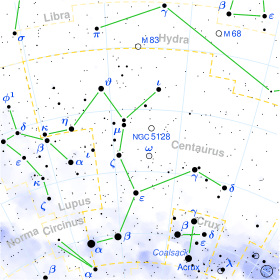Omicron1 Centauri
Omicron1 Centauri (ο1 Cen, ο1 Centauri) is a star in the constellation Centaurus. It is approximately 6,000 light years from Earth.
 | |
| Observation data Epoch J2000.0 Equinox J2000.0 | |
|---|---|
| Constellation | Centaurus |
| Right ascension | 11h 31m 46.07s[1] |
| Declination | −59° 26′ 31.4″[1] |
| Apparent magnitude (V) | +5.13[2] |
| Characteristics | |
| Spectral type | G3 0-Ia[3][4] |
| B−V color index | +1.08[2] |
| Variable type | SRd[5] |
| Astrometry | |
| Radial velocity (Rv) | −20.00[6] km/s |
| Proper motion (μ) | RA: -4.31 ± 0.28[1] mas/yr Dec.: 1.72 ± 0.28[1] mas/yr |
| Parallax (π) | 0.57 ± 0.32[1] mas |
| Distance | approx. 6,000 ly (approx. 1,800 pc) |
| Absolute magnitude (MV) | −9.0[4] |
| Details | |
| Mass | 17[7] M☉ |
| Radius | 270[7] R☉ |
| Luminosity | 68,000[7] L☉ |
| Surface gravity (log g) | 0.19[8] cgs |
| Temperature | 4,873[9] K |
| Age | 10–12[7] Myr |
| Other designations | |
| Database references | |
| SIMBAD | data |
ο1 Centauri is a yellow G-type supergiant or hypergiant with a mean apparent magnitude of +5.13. It is classified as a semiregular variable star and its brightness varies from magnitude +5.8 to +6.6 with a period of 200 days.[5] Other studies have reported only small brightness variations.[10][11] It is the MK spectral standard for class G3 O-Ia,[12] indicating a highly luminous mass-losing hypergiant star. It has also be classified as F8 Ia0[13] and F7 Ia/ab.[14] The size, luminosity, and distance are equally uncertain.
ο1 Cen forms a very close naked eye double star with ο2 Cen, a hotter supergiant that may be physically associated. ο1 has an 11th magnitude companion only 13.5" distant.[15]
References
- van Leeuwen, F. (2007). "Validation of the new Hipparcos reduction". Astronomy and Astrophysics. 474 (2): 653–664. arXiv:0708.1752. Bibcode:2007A&A...474..653V. doi:10.1051/0004-6361:20078357. Vizier catalog entry
- Malyuto, V.; Schmidt-Kaler, T. (1997). "Quantitative spectral classification based on photoelectric spectrum scanner measurements of F-K stars". Astronomy and Astrophysics. 325: 693. Bibcode:1997A&A...325..693M.
- Keenan, P. C.; Pitts, R. E. (1980). "Revised MK spectral types for G, K, and M stars". Astrophysical Journal Supplement Series. 42: 541. Bibcode:1980ApJS...42..541K. doi:10.1086/190662.
- Arellano Ferro, A.; Giridhar, Sunetra; Goswami, Aruna (1991). "A new discussion on the M(v) - W(O I 7774 A) relationship for F-G stars in the light of high-resolution data". Monthly Notices of the Royal Astronomical Society. 250: 1. Bibcode:1991MNRAS.250....1A. doi:10.1093/mnras/250.1.1.
- Samus, N. N.; Durlevich, O. V.; et al. (2009). "VizieR Online Data Catalog: General Catalogue of Variable Stars (Samus+ 2007-2013)". VizieR On-line Data Catalog: B/gcvs. Originally Published in: 2009yCat....102025S. 1. Bibcode:2009yCat....102025S.
- Gontcharov, G. A. (2006). "Pulkovo Compilation of Radial Velocities for 35 495 Hipparcos stars in a common system". Astronomy Letters. 32 (11): 759. arXiv:1606.08053. Bibcode:2006AstL...32..759G. doi:10.1134/S1063773706110065.
- Kaler, James B., "Omicron 1,2 Centauri", Stars, University of Illinois, retrieved 2017-12-05
- Mallik, Sushma V. (1998). "The central depth of the Ca II triplet lines as a discriminant of chromospheric activity in late type stars". Bulletin of the Astronomical Society of India. 26: 479. Bibcode:1998BASI...26..479M.
- McDonald, I.; Zijlstra, A. A.; Boyer, M. L. (2012). "Fundamental parameters and infrared excesses of Hipparcos stars". Monthly Notices of the Royal Astronomical Society. 427: 343. arXiv:1208.2037. Bibcode:2012MNRAS.427..343M. doi:10.1111/j.1365-2966.2012.21873.x.
- Friedrich, D.; Schoffel, E. (1971). "New Bright Southern Variable Stars". Information Bulletin on Variable Stars. 558: 1. Bibcode:1971IBVS..558....1F.
- Sterken, C.; Manfroid, J.; Anton, K.; Barzewski, A.; Bibo, E.; Bruch, A.; Burger, M.; Duerbeck, H. W.; Duemmler, R.; Heck, A.; Hensberge, H.; Hiesgen, M.; Inklaar, F.; Jorissen, A.; Juettner, A.; Kinkel, U.; Liu, Zongli; Mekkaden, M. V.; Ng, Y. K.; Niarchos, P.; Puttmann, M.; Szeifert, T.; Spiller, F.; Van Dijk, R.; Vogt, N.; Wanders, I. (1993). "Longterm Photometry of Variables at ESO - Part Two - the Second Data Catalogue 1986-1990". Astronomy and Astrophysics Supplement. 102: 79. Bibcode:1993A&AS..102...79S.
- Garcia, B. (1989). "A list of MK standard stars". Bulletin d'Information du Centre de Données Stellaires. 36: 27. Bibcode:1989BICDS..36...27G.
- Mantegazza, L. (1992). "Luminosities of yellow supergiants from near-infrared spectra - Calibration through Magellanic Cloud stars". Astronomy and Astrophysics. 265: 527. Bibcode:1992A&A...265..527M.
- Sowell, James R. (1990). "A survey of Balmer-line profiles and IRAS fluxes in forty yellow supergiants". Astronomical Journal. 100: 834. Bibcode:1990AJ....100..834S. doi:10.1086/115567.
- Mason, Brian D.; Wycoff, Gary L.; Hartkopf, William I.; Douglass, Geoffrey G.; Worley, Charles E. (2001). "The 2001 US Naval Observatory Double Star CD-ROM. I. The Washington Double Star Catalog". The Astronomical Journal. 122 (6): 3466. Bibcode:2001AJ....122.3466M. doi:10.1086/323920.